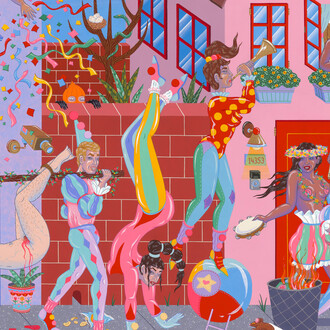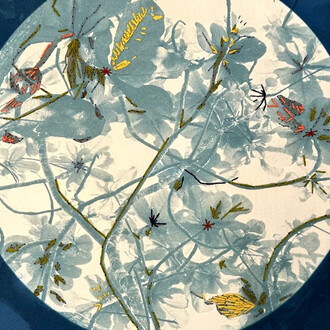GGLA is proud to present Homecourt, a group exhibition featuring works by Diana Yesenia Alvarez, Michelle Grabner, Jasmine Little, Maija Peeples-Bright, Sofie Ramos, Rosie Lee Tompkins, Cate White and Maryam Yousif. Set within the confines of a house at 3415 Verdugo Road, Homecourt examines themes ranging from craft, gender, labor and all the ways in which we inhabit, transform and are transformed by a space.
In a broad stroke, so much of the art historical canon of post-war American art feels as if it’s a rejection of the domestic sphere entirely–an embrace of puffed out chest machismo and a shunning of craft and functionality and anything that could be seen as remotely feminine. Take ceramics for example, the larger fine art world ignored this “craft” medium until artists like Peter Voulkos literally tore apart the utilitarian vessel, violently incising and exploding this classical form. Thankfully much of the discourse over the past decade(s) has been about rectifying the oversights that came with shunning the domestic, the utilitarian, the craft technique, and the accompanying women and people of color that had mastered and transformed these traditions. Artists such as Rosie Lee Tompkins come to mind–the Bay Area based quilter who’s wildly improvisational process and freewheeling approach to materiality and composition had the art critic Roberta Smith dub her, “one of the great American artists”, an accolade that sadly came posthumously. Yet Topmkins remains in spirit and we’re all blessed to have one of her larger works grace this exhibition; the composition of intersecting triangle swatches cut from floral and other pastel fabrics, bordered with a bright grass green border, all buzzing with an optical energy and an inherited wisdom passed down from maker to maker.
Artist, educator, curator and critic, Michelle Grabner’s Untitled (2023) forms an instant kinship with Tompkins’ quilt. Grabner’s oil-painted bronze sculpture was cast directly from a crocheted textile, with all of the delicacy, labor and vulnerability of the original textile converted into a kind of armor. Grabner’s use of oil paint on the textile turned bronze introduces an almost psychedelic element as hits of color nestle themselves between thin leads of yarn. Los Angeles-based artist Sofie Ramos touches on themes of unseen labor involved with housekeeping and laundry by way of her sculptural painting that at first glance resembles a pile of clothes waiting for the wash. A closer inspection reveals that each sock or scrunchie has been carefully dipped in a different cacophonous shade of latex paint and laid in place by the artist–an expansive fusion of painting and sculpture which explores mark-making in a whole new way. Cate White’s painting Family room takes a more traditional approach to painting, yet employs the artist’s biting sense of humor and full embrace of the uncomfortable. Centering on a nude male figure who playfully lounges on a bear skin rug, returning the viewer’s gaze through his aviator sunglasses with a naive self-absorption. The room around him, thick shag rug, and stone fireplace with a bald eagle statue, wavy candlesticks and a small Kool-Aid man vessel gives the feel of a 70’s ranch home. As is typical with White’s paintings, parts of the composition drift in and out of form and focus, giving the image the feel of a distant forbidden memory, or even better, a 4 x 6 print discovered deep in the bins of a local thrift store–a portal to a complete stranger’s sensual escapades.
With a humor and vivacious energy that matches the painting of Cate White are the brilliant ceramics of Sacramento-based funk art legend Maija Peeples-Bright. Seamlessly fusing form, function and figuration, Peeples-Bright moves from sculptural ceramic lamps to cups and vases, and even a chicken-beaked teapot. Never trained in ceramics, Peeples-Bright has an intuitive and free-wheeling approach to the material, and like most of her work, hierarchies of good and bad taste are thrown out the window in favor of uninhibited joy, embodied perfectly by the smiling green alligator that wraps itself around one of the artist’s beautiful lamps from the 1970’s. Speaking to the works of Peeples-Bright are Los-Angeles based ceramicist Jasmine Little’s pots which are adorned with more and more pots. The straight-walled stoneware vessels maximize their humble materials; the gritty deep red stoneware pots are only decorated with black and white glaze, yet through incising into the wet clay painted with a white slip, Little creates intricate drawings of pots that pay homage to ancient ceramic traditions such as Greek amphora while injecting the imagery on the vessels with contemporary imagery and humor. Furthering the exploration of the vessel is Los Angeles-based Diana Yesenia Alvarado’s Spacestone, a large and slumping footed vessel with guttural elements that protrude and recede back into the deeply textured surface. The piece’s title rings true as Alvarado experiments with a mixture of dark metallic glazes that melt into deeper greens, fading lighter as the base of the work thins out. Speaking to all of these works and the history of ceramics are the works of San Francisco-based artist Maryam Yousif, who uses clay as a means of exploring her heritage and birthplace of Iraq. Yousif’s latest work, Palms in mosaic basket features a square basket with abstract mid-century designs on all four sides, imagery that references a mosaic that was built into one of Saddam Hussein’s many palaces, now defunct, the unruly bodies of small palm trees pop out from the basket as if in an act of rogue reclamation.
















